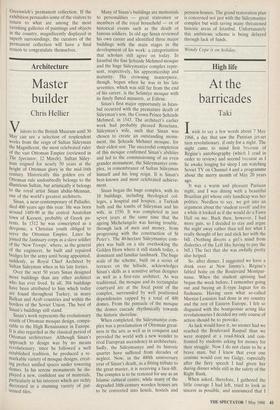Exhibitions 2
Armada (National Maritime Museum, till 4 September)
D-day 1588
John Keegan
The exhibition staged at the National Maritime Museum, Greenwich, to com- memorate the 400th anniversary of the Spanish Armada is one of the most elabo- rate ever mounted in this country as a reconstruction of an historical event. A large part of the museum has been inter- nally refitted to simulate the panelled rooms of a 16th-century nobleman's house. The cases are an integral part of the refitting, which also includes a number of
dioramas and waxwork displays of high authenticity.
The exhibits have been assembled from a wide variety of sources, including the Vatican Museum, the Vienna Military History Museum — one of the greatest and least known of European treasure-houses — the Paris Carnavalet, the Rijksmuseum, Amsterdam, as well as many museums of the Spanish Patrimonio Nacional. The Spanish have been especially generous, in two senses: they have given freely of objects; they have also co-operated wholeheartedly in the realistic depiction of what for them is still a painful national humiliation.
That their co-operation was won is due to the organisers' sensible decision to narrate the events of 1588 not as 'the defeat of the Spanish Armada' by Eli- 'The launch of the English fireships against the Armada at Calais, 7 August 1588'. Oil painting, Netherlandish school, 16th century. From the National Maritime Museum's permanent collection.
zabeth's England but as a pan-European drama. A large part of the display is therefore dedicated to the religious crisis of the 16th century, to the revolt of the Netherlands against Spain, to the structure of the Spanish empire and to the interna- tional relations of Northern Europe before the Armada sailed. A particularly success- ful display is a reconstruction of Philip II's monastic study-cell in the Escorial from which the empire was ruled and the Arma- da commanded.
These displays lead on to the organisa- tion and direction of the Armada itself, to the co-ordination of English counter- measures, to the technology of contempor- ary naval and land warfare, to the course of the campaign and to its tragic aftermath. They are varyingly successful. 'Life on Board', 'Medicine' and 'Navigation' de- pend on the visitor exercising his imagina- tion over some fairly conventional displays of buttons, platters, scalpels, backstaffs, musket balls, footwear and shipboard trifles, many plucked from the deep and looking none the better for their immer- sion. This is not the organisers' fault. The objects are intrinsically uninteresting, part- ly because richer exhibits have not sur- vived, partly because the technology is indeed primitive. The navigational instru- ments, for example, compare badly with those from the 18th century in the museum's permanent display, which are often treasures of art as well triumphs of ingenuity.
The military material is more arresting. The collection of armour from the village church at Mendlesham, Suffolk, represent- ing the equipment available to a local defence force in Elizabeth's reign, evokes a genuine archaelogical pang. Here was all her Dad's Army had with which to con- front the arquebusiers and artillerymen of the Spanish tercios, the stormtroopers of contemporary battlefields.
Best of all are the portraits of the commanders, particularly the English com- manders, and the military documentation they had prepared for the conduct of the campaign. The sketch maps of coast forti- fications, beacon systems and harbour defences, the charts of enemy naval ports, the lists of troops available for defence are of extraordinary quality. They are instantly reminiscent of the staff planning papers for the invasion of Normandy in 1944 and demonstrate that the Armada was not defeated by good luck.
There is nothing, either, in the faces of the English admirals and sea captains that suggests they would leave things to chance. Sir Richard Hawkins, captain of the Swal- low, gives the visitor the sort of look that makes him thankful he was not navigating a ship up-Channel in August 1588. It is repeated in even more savage style on the face of Sir Richard Bingham, by whom hundreds of Spanish survivors of the great gale which was the real cause of the Armada's defeat were killed in cold blood on the west coast of Ireland in September. The wars of religion were not gentlemen's wars.
If only by conveying that truth, the Armada exhibition is a brilliant success. Its organisers must also be commended for having produced one of the most intelli- gent and informative catalogues of a major exhibition that could ever be devised (Armada, Penguin, f12.95). It is a valuable and scholarly history of the Armada year as well as a beautiful guide to the exhibits — some of which, of course, are from
Greenwich's permanent collection. If the exhibition persuades some of the visitors to return to what are among the most ravishing galleries of paintings and objects in the country, magnificently displayed in superb surroundings, the curators of the permanent collection will have a final reason to congratulate themselves.























































 Previous page
Previous page